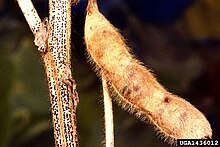| Diaporthe | |
|---|---|
 | |
| Diaporthe damage on soybean plant | |
| Scientific classification | |
| Domain: | Eukaryota |
| Kingdom: | Fungi |
| Division: | Ascomycota |
| Class: | Sordariomycetes |
| Order: | Diaporthales |
| Family: | Diaporthaceae |
| Genus: | Diaporthe Nitschke (1870) |
| Type species | |
| Diaporthe eres Nitschke (1870) | |
| Species | |
See text | |
Diaporthe is a genus of endophytic filamentous fungal plant pathogens.
Contents
Diaporthe species have been shown to transform the infection-inhibiting factors (+)-catechin and (−)-epicatechin into the 3,4-cis-dihydroxyflavan derivatives. [1]
Some species, like Diaporthe toxica , produce secondary metabolites that result in toxicoses of animals such as lupinosis of sheep. [2]


